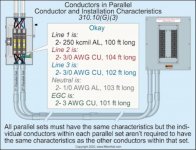I've been going over this material to a point, then I go bact to the beginning and do it again.
If I ever feel like I'm not understanding, I go back to the fundamentals and cover it again.
But this slide challenges everything I know about the fundamentals.

Mr. Holt says there is no violation in this scenario....
But... 310.10(G)(2) says the paralleled condunctors of each (phase) must comply with (1)-(5).
If a phase consists of two different phase conductors then a phases are L1-L2, L2-L3, and L3-L1.
So all three phases are in each raceway.
Since the phases must comply with (G)(2), I would interpret the meaning of G(3) to be each set of conductors paralleled in a raceway must be the same, but they don't have to be the same as a set of paralleled conductors in another raceway.
From a fundamentals aspect, in order to cancel out the inductive reactance in each raceway, the above graphic dosen't make sense.
If I'm wrong, then please help me get back on track.
If I ever feel like I'm not understanding, I go back to the fundamentals and cover it again.
But this slide challenges everything I know about the fundamentals.

Mr. Holt says there is no violation in this scenario....
But... 310.10(G)(2) says the paralleled condunctors of each (phase) must comply with (1)-(5).
If a phase consists of two different phase conductors then a phases are L1-L2, L2-L3, and L3-L1.
So all three phases are in each raceway.
Since the phases must comply with (G)(2), I would interpret the meaning of G(3) to be each set of conductors paralleled in a raceway must be the same, but they don't have to be the same as a set of paralleled conductors in another raceway.
From a fundamentals aspect, in order to cancel out the inductive reactance in each raceway, the above graphic dosen't make sense.
If I'm wrong, then please help me get back on track.

